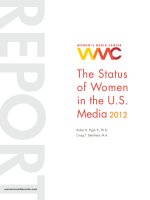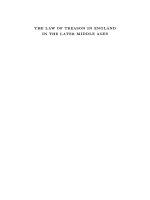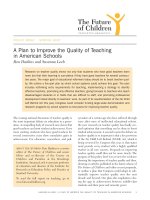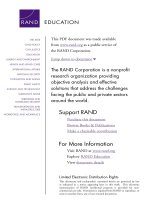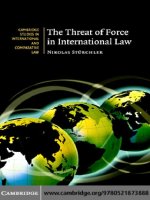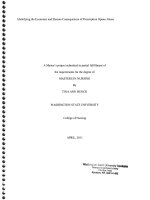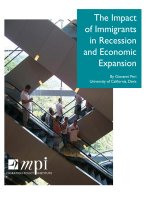The subjectivity of adjectives in spoken mandarin
Bạn đang xem bản rút gọn của tài liệu. Xem và tải ngay bản đầy đủ của tài liệu tại đây (2.38 MB, 334 trang )
THE SUBJECTIVITY OF ADJECTIVES IN SPOKEN
MANDARIN
SHANG GUOWEN
NATIONAL UNIVERSITY OF SINGAPORE
-2011-
THE SUBJECTIVITY OF ADJECTIVES IN SPOKEN
MANDARIN
SHANG GUOWEN
A THESIS SUBMITTED IN PARTIAL FULFILMENT
OF THE REQUIREMENTS FOR THE DEGREE OF
DOCTOR OF PHILOSOPHY
DEPARTMENT OF ENGLISH LANGUAGE AND LITERATURE
NATIONAL UNIVERSITY OF SINGAPORE
-2011-
iii
Acknowledgements
First I wish to extend my sincere gratitude and thanks to my supervisor, Dr. Peter
Tan Kok Wan, for his continuous encouragement and support throughout my thesis
writing. He is an open-minded scholar, who allows me to explore the linguistic
phenomena that cater to my interests. He is patient and always ready to provide
assistance whenever I approach him for advice. I have especially valued his efficient,
detailed and constructive feedbacks on the drafts of my thesis. Without his kind help, I
would not get to this point of completion. Moreover, his rigorous attitude in teaching
and research is a role model in my professional and personal life.
My thanks also go to my thesis committee members Prof. Ismail S. Talib and Dr.
Ho Chee Lick, and my good friends Zhang Ruihua, Liu Yu, Lin Jinzhan and Bai
Xiaopeng, for their enlightening perspectives and suggestions. I also owe a debt to
Prof. Bao Zhiming, Peter Wignell, Tomasina Oh and Lionel Wee in the Department of
English Language and Literature and Prof. Shi Yuzhi and Peng Rui in the Chinese
Department, whose lectures, handouts and monographs informed this study.
Finally, I wish to express my thanks to my wife and my parents for their
unconditional understanding and support for my study. They have undertaken all the
household chores during my thesis writing, thus I can concentrate on my study in
these years. I would like to dedicate this thesis to them.
iv
Abstract
The syntactic and semantic features of adjectives in the Chinese language have
been extensively studied, whereas their pragmatic features are underexplored in
linguistics. This thesis takes the category of adjectives primarily as subjectivity
markers, investigating how the speakers’ attitudes or evaluations are conveyed in
spoken Mandarin. The adjectives in Mandarin can be used to fulfil five basic
pragmatic functions, namely subcategorization, identification, evaluation,
specification and depiction. Among them, the evaluation function predominates in
spoken discourse. The adjectival evaluations in Mandarin are essentially
reference-point constructions. That is, people implicitly or explicitly compare with
certain standards or values when evaluating the quality or property of entities/events.
The nature of the referenced standards or norms determines the subjectivity or
objectivity of the adjectival evaluations. As a special type of qualitative adjectives, the
affective adjectives in use can be absolutely subjective or relatively subjective. In
addition, the typical adjectival constructions in Mandarin such as adjectival negation,
intensification and reduplication all demonstrate the speakers’ subjectivity in that the
speakers’ construal to the normal property values of entities/events or the speakers’
expectations will be accessed in the evaluation process. In general, the category of
adjectives is typically used to register the speakers’ attitudes or emotions in spoken
Mandarin. The analysis in this study reveals that the linguistic expressions are not
autonomous, but are often motivated or constrained by a wide range of pragmatic and
cognitive principles.
v
Abbreviations
BA marker of the BA construction
BEI passive marker bei
CL classifier
DE pre-nominal modification marker, postverbal resultative marker, or
sentence-final particle de
EM exclamation markers such as a, wa, and la
GUO experiential aspect marker guo
LE perfective marker or sentence-final particle le
lit. literally means
PL plural
QM question marker
ZHE durative aspect marker zhe
1s first person singular pronoun
1p first person plural pronoun
2s second person singular pronoun
2s(h) second person singuralr pronoun in honorific form
2p second person plural pronoun
3s third person singular pronoun
3p third person plural pronoun
vi
Tables and Figures
Tables
Table 3.1 Distribution of spoken data………………………………………………………75
Table 4.1 The pragmatic functions of adjectives in Mandarin…………………… 104
Table 4.2 Functional distribution of adjectives in spoken Mandarin 122
Table 7.1 Features of gradable adjectives and their negation 205
Figures
Fig 2.1 “Optimal” and “egocentric” viewing arrangements…………………………51
Fig 5.1 A reference-point construction 130
Fig 5.2 Normality and attention 136
Fig 5.3 Value cline for fast 160
Fig 5.4 Objectivity-subjectivity continuum 164
Fig 5.5 An evaluation system 168
Fig 7.1 Conceptualization of limit adjectives 193
Fig 7.2 Binary scale 196
Fig 7.3 Unary scale 198
Fig 7.4 Double-closed scale 200
Fig 7.5 Conceptualization of a half glass of water 202
Fig 7.6 Semi-closed scale 202
Fig 9.1 State adjectives projected on the property scale 265
vii
Table of Contents
Acknowledgements……………………………………………………………… ……iii
Abstract…………………………………………………………………………………iv
Abbreviations ……….………………………………………………………………….v
Tables and Figures…………………………………………………………………… vi
Chapter 1 Introduction…………………………….………………….… ……….… 1
1.1 Mandarin Adjectives: Preliminaries……….………………….……….…… ….1
1.1.1 Positioning the Adjectives in Mandarin…… ………….………….……….2
1.1.2 Scope of Adjectives in this Thesis… ………………….…….….…………6
1.1.3 Syntactic and Semantic Features of Mandarin Adjectives…….….……….10
1.1.4 A Review of Mandarin Adjective Studies…………….……….….….……18
1.2 Subjectivity in Language and Linguistics………………………….…… …….22
1.3 The Subjectivity of Mandarin Adjectives ……………………….…… …….26
1.4 Research Questions……………………………………………………….…….30
1.5 Purpose and Objectives ……………………………… ………….….….… 31
1.6 Organization of the Thesis…………………………………………… … ….33
Chapter 2 An Overview of Subjectivity Studies……………………… …….…… 34
2.1 The Notion of Linguistic Subjectivity………………………………… …… 34
2.2 A Brief History of Linguistic Subjectivity Studies……………….………….…37
2.3 Subjectivity Realization Devices……………………………… …………… 42
2.4 Speaker Subjectivity and Perspectival Subjectivity …… ………………….44
2.5 Linguistic Approaches to Subjectivity ………………….…………………….48
2.5.1 Perspective Studies…………………………………………… …………49
2.5.1.1 Langacker’s Construal Approach ……………………………… 50
2.5.1.2 Kuno’s Empathy Perspective……………………………………….54
2.5.2 Affect Studies……………………………………………………………57
2.5.3 Evaluation Studies……………………………………………………….58
2.5.3.1 Criteria for Evaluative Language………………………………… 59
2.5.3.2 Linguistic Approaches to Evaluation……………………………….62
2.5.3.2.1 Stancetaking Models…… ……………………………………62
2.5.3.2.2 Parameter-based Approaches………… … ………………64
2.5.3.2.3 Appraisal Theory……………………………………………….67
2.6 What ‘Subjectivity’ Means in this Thesis………… ………………………… 70
Chapter 3 The Data…… ……………………………………………………… 72
Chapter 4 Basic Pragmatic Functions of Mandarin Adjectives…………… ….…77
4.1 Introduction …………………………………………………… ……… 77
viii
4.2 Basic Pragmatic Functions of Mandarin Adjectives …………………….…80
4.2.1 The Function of Subcategorization…………………………………….…80
4.2.2 The Function of Identification……………………………………… ….85
4.2.3 The Evaluation Function…………………………………………… … 89
4.2.4 The Function of Specification……………………………………… 93
4.2.5 The Function of Depiction………………………………………….… …98
4.2.6 Co-occurrence of Pragmatic Functions …………………………….… 103
4.3 Relationship between Syntactic and Pragmatic Functions of Adjectives .… 106
4.3.1 The Pragmatic Functions of Attributive Adjectives ………… … … 107
4.3.2 The Pragmatic Functions of Predicative Adjectives……………….….… 110
4.3.3 The Pragmatic Functions of Adverbial Adjectives …………… ….… 113
4.3.4 The Pragmatic Functions of Complement Adjectives…………… ….… 117
4.4 Adjectives of Various Pragmatic Functions: Distributions in Spoken Discourse
120
4.5 Summary 124
Chapter 5 Adjectival Evaluation as Reference-Point Constructions 126
5.1 Introduction 126
5.2 Adjectival Evaluation as Reference-Point Constructions 128
5.2.1 Reference Points and Reference-Point Constructions 128
5.2.2 Adjectival Evaluation as Reference-Point Constructions 131
5.2.2.1 Reference Points for Adjectival Evaluation 132
5.2.2.1.1 Explicit Reference Points and Adjectival Evaluation 133
5.2.2.1.2 Implicit Reference Points and Adjectival Evaluation 134
5.2.2.2 Frames and Evaluation 148
5.2.2.2.1 The Notion of Frame 149
5.2.2.2.2 Evaluation in Frames 150
5.3 Objectivity and Subjectivity of Adjectival Evaluations 153
5.3.1 Objectivity of Adjectival Evaluations 153
5.3.2 Subjectivity of Adjectival Evaluations 157
5.3.2.1 The Subjective Evaluations 157
5.3.2.2 Motivations for the Subjectivity of Adjectival Evaluations 158
5.3.3 Continuum of Subjectivity and Objectivity 162
5.4 Interactive Function of Adjectival Evaluation 164
5.4.1 Value Positioning Function 165
5.4.2 Manipulation of the Hearers 166
5.5 An Overall Adjectival Evaluation System 168
5.6 Summary 169
Chapter 6 The Functions and Subjectivity of Affective Adjectives 171
6.1 Introduction 171
6.2 Syntactic and Pragmatic Functions of Affective Adjectives in Mandarin.… 173
ix
6.2.1 Syntactic Behaviours of Affective Adjectives 173
6.2.2 Pragmatic Functions of Affective Adjectives 176
6.3 Subjectivity of Affective Adjectives in Mandarin 178
6.4 Summary 181
Chapter 7 Meanings and Functions of Adjectival Negation 183
7.1 Introduction 183
7.2 Semantic Conditions for Adjectival Negation 188
7.3 Semantic Features of Adjectival Negation 191
7.3.1 Limit Adjectives and Negation 192
7.3.2 Scalar Adjectives and Negation 196
7.3.3 Extreme Adjectives and Negation 199
7.3.4 bu A bu B: A Special Construction of Adjectival Negation 203
7.3.5 Summary 204
7.4 Subjectivity of Adjectival Negation 206
7.5 Discursive-Pragmatic Functions of Adjectival Negation 209
7.5.1 Communicative Pragmatics of Adjectival Negation 210
7.5.2 Adjectival Negation and Politeness Principle 212
7.6 Summary 216
Chapter 8 Intensification of Mandarin Adjectives 218
8.1 Introduction 218
8.2 Encoding Principle for Adjectival Evaluation 221
8.3 Intensification of Adjectival Evaluation 224
8.3.1 hen ‘very’ 225
8.3.2 zhen ‘really’ 229
8.3.3 tai ‘too’ 233
8.3.3.1 tai A le: A Positive Deviation 234
8.3.3.2 tai A: A Negative Deviation 235
8.3.4 gou ‘enough’ 238
8.3.5 shaowei ‘slightly’ and youdian ‘a bit’ 245
8.3.5.1 shaowei ‘slightly’ 245
8.3.5.2 youdian ‘a bit’ 247
8.4 Summary 250
Chapter 9 Meaning and Functions of Adjectival Reduplication 251
9.1 Introduction 251
9.2 Grammatical Functions of Adjectival Reduplication: An Overview 255
9.2.1 Vividness 255
9.2.2 Expressing Emotional Attitudes 257
9.2.3 Quantification 260
x
9.3 Quantification of Adjectival Reduplication in Mandarin 264
9.3.1 Adjectives and Property Scale 264
9.3.2 Quantification of Reduplicative Adjectives 268
9.3.2.1 Syntactic behaviours of Reduplicative Adjectives 268
9.3.2.2 High-degree Meaning of Reduplicative Adjectives 271
9.4 The Subjectivity of Reduplicated Adjectives 276
9.4.1 Reduplicative Adjectives and Evaluation 276
9.4.2 Reduplicative Adjectives and Speaker’s Certainty 283
9.4.3 Reduplicative Adjectives and Speaker’s Expectation 285
9.5 Intersubjectivity of Reduplicative Adjectives 288
9.6 Summary 292
Chapter 10 Conclusions 294
10.1 Summary of Major Findings 294
10.2 Significance of the Study 298
10.3 Limitations and Further Works 300
Appendix 302
Bibliography 303
1
Chapter 1
Introduction
1.1 Mandarin Adjectives: Preliminaries
Adjectives, like nouns and verbs, constitute one of the basic lexical categories in
human language systems. The research of cross-linguistic typology shows that the
category of adjectives finds its existence in almost every human language (cf. Bhat,
1994; Dixon, 2004). However, the membership of the adjective category in these
languages varies enormously. The number of adjectives can be as large as over one
thousand in some languages such as English and Mandarin, or as small as less than ten
in some other languages like Lgbo and Supyire (Dixon, 2004). The prevalence of
adjectives in human languages demonstrates their paramount role in people’s
conceptualization of the world. One may realize that numerous concepts concerning
properties such as length, size, height, quality, performance and emotion, are normally
represented via adjectives in our daily speech. For instance, we often assess the price of
commodities as cheap or expensive, the work performance of a person as good or bad,
the temperature of a place as hot or cold, and so forth. Without resorting to the adjective
category, the designation of the same conceptions would be a periphrastic and
complicated task for language users. Therefore, the significance of adjectives in a
language system as well as in communication cannot be exaggerated.
Despite its ubiquity in human languages, fewer academic endeavours have been
made to the category of adjectives than nouns and verbs (Bhat, 1994). The reason is still
unclear, yet the ill-defined nature of adjectives partially contributes to the situation. In
2
the literature, adjectives are typically defined as a category “denoting qualities or
properties of things” (Quirk et al., 1985; Bhat, 1994; Tucker, 1998). The broad notion of
‘things’, as it is, encapsulates a long list of concepts such as objects, situations, human
beings, processes and propositions. The notions of ‘qualities’ and ‘properties’, on the
other hand, are so vague that they barely provide reliable criteria for the distinction of
adjectives from other lexical categories. Given the inadequacy of the semantic definition,
one may have to resort to the typical syntactic behaviours of adjectives (e.g., often
modifiable by adverbs like very, functioning as noun premodifiers, occurring in
comparative constructions) to determine whether a lexical item is an adjective or not (cf.
Quirk et al., 1985).
A similar dilemma exists for the definition of adjectives in the Chinese language,
where the identity of this large open-class category is hard to be adequately captured.
Despite this definitional inadequacy, the grammatical features and functions of the
adjectives in Mandarin have been extensively explored in Chinese linguistics (cf. Zhu,
1956/1980, 1982; Shen, 1999; Liu, et al., 2001; Shi, 2001, 2003; Wang, 2003; Paul,
2005; Zhang, 2006). In this thesis, the pragmatic and interpersonal aspects of the
adjective category in Mandarin will be closely examined in order to deepen our
understanding of the uses of adjectives in communication.
1.1.1 Positioning the Adjectives in Mandarin
Since this study is targeted at the adjectives in spoken Mandarin, the fundamental
issue that needs to be clarified at the outset is the positioning of the adjective category
in the Chinese language. Here the notion MANDARIN, also known as putonghua ‘standard
3
language’ in Mainland China, guoyu ‘national language’ in Taiwan, or huayu ‘Mandarin’
in Singapore, is often “nontechnically regarded as an equivalent to Chinese” (Gu,
2008:215). As the modern standard Chinese language, Mandarin Chinese is
characterized by “embodying the pronunciation of Beijing Dialect, the grammar of
northern Mandarin, and the vocabulary of modern vernacular literature” (Li and
Thompson, 1981:1). Despite the numerous ‘dialects’ or ‘idiolects’ in various speech
communities of Mandarin, this thesis takes MANDARIN as a convenient shorthand for
modern Chinese, namely the lingua franca for Chinese speakers. Now the question is, is
there a lexical category called adjectives in Mandarin?
The positioning of adjectives in Chinese grammar has long been a hotly debated
topic in linguistic studies. Since there is no clear-cut demarcation between adjectives
and other categories such as nouns, verbs and adverbs, the adjective category has
evoked tremendous controversy in Chinese linguistics. Their arguments centre on at
least two issues: does the Chinese language have the category of adjectives? If yes, to
what extent does it differ from or overlap with other lexical categories? With regard to
the first question, most Chinese scholars respond positively since they realize that the
quality/property words may fulfil some special grammatical functions obviously distinct
from other lexical categories. Therefore, the adjectives in Chinese constitute a basic
lexical category parallel with nouns and verbs. Mandarin adjectives, according to them,
form an open-class lexical category, comprising an “unrestricted, indeterminately large,
membership” (Lyons, 1968:436). For instance, Zheng and Meng (2003) have analyzed
the usages of altogether 1,067 adjectives in Chinese, whereas Fu (2007) has collected
4
over 4,000 adjectives, though a number of them are arguably descriptive expressions
rather than adjectives. Most scholars seem to agree that the adjective category in
Mandarin is a prototypical conception, with the marginal adjectives bordering on other
categories.
However, under the influence of the traditional Indo-European linguistics, some
earlier Chinese linguists conceived of the adjectives in Chinese as verbs or a
subcategory of verbs owing to the facts that the syntactic behaviours of the category
resemble the verbs in the language (cf. Chao, 1968; Li and Thompson, 1981; Zhu, 1982;
McCawley, 1992). Among them, Li and Thompson (1981) suggest that Mandarin
adjectives behave like verbs in three ways:
First, in Chinese, words denoting qualities and properties do not occur with a copula as they
do in Indo-European languages. …Second, quality and property words in Chinese are negated
by the same particle bù as are verbs…Thirdly, when an ‘adjective’ modifies a noun, it occurs
with the same nominalizing particle de as verb phrases do. (Li and Thompson, 1981: 826-827)
Given these facts, they argue that it is sensible to regard the quality and property words
in Chinese as adjectival verbs, namely a subclass of verbs. Even today, this view is still
advocated by many western scholars. Similarly, McCawley (1992) claimed that the
Chinese language does not have a category of adjectives at all; all of the so-called
adjectives are essentially verbs.
It is true that in Chinese there are few recognizable morphological forms based on
which different parts of speech are identified. When one refers to the semantic criteria
and even the syntactic functions of adjectives in Mandarin, he/she will immediately
realize that the boundary of the adjective category is too vague and considerable
5
overlaps occur between adjectives and other categories. Thus the second issue has
baffled numerous linguists engaging in Chinese grammar studies, making them doubt
the identity of adjectives in Mandarin.
In this thesis, I contend that adjectives constitute a basic lexical category in
Mandarin. I take this position based on two reasons.
Firstly, the unclear boundaries between adjectives and other lexical categories are
also seen in other languages. Dixon’s (1982, 2004) typological study indicates that there
are many languages where adjectives are not distinct from nouns or verbs as in English.
For instance, most languages of Europe, North Africa, North Asia and Australia tend to
treat adjectives in a similar way to nouns, whereas in a large number of languages found
over most of North America, East and Southeast Asia and also the Pacific, adjectives are
morphologically indistinguishable from verbs. That is, adjectives may syntactically
function as sentential subjects or objects, making the adjective category border the noun
category; adjectives may also appear as sentence predicates, a function primarily
realized by verbs. In spite of this, scholars acknowledge that adjectives constitute a
basic lexical category in these languages. If the adjective category is acknowledged in
these languages, the lack of morphological distinction from other lexical categories
should not be a factor for denying the existence of the adjective category in Mandarin.
Secondly, the Mandarin adjectives are essentially parallel to the adjectives in other
languages in terms of semantic meanings and grammatical functions. It has been shown
that the adjectives in Mandarin denote the quality or property of things. Syntactically,
the prototypical members can be modified by degree modifiers like hen ‘very’, function
6
as noun modifiers and occur in comparative constructions (see 1.1.3 for a detailed
discussion of the syntactic and semantic functions of adjectives in Mandarin). These
grammatical features are shared by the adjectives in other languages like English. Given
such an array of similarities, it would be inconsistent to recognize the adjective category
in other languages while rejecting the category of adjectives in Mandarin. These
scholars put an undue focus on the similarities between adjectives and verbs while
ignoring the distinctive grammatical functions of adjectives in Chinese.
In brief, the adjectives in Mandarin form a basic lexical category, which is
prototypical in nature, with the peripheral members bordering other lexical categories
like verbs, nouns and adverbs.
1.1.2 Scope of Adjectives in this Thesis
I have shown in the previous section that due to the lack of reliable morphological
distinctions between adjectives and other lexical categories, the boundaries of the
adjective category in Chinese are rather vague. However, it is a necessary first step to
define the scope of adjectives before the investigation of their functions in use. In this
section, the general principles for differentiating adjectives from other categories will be
illustrated.
(I) Adjectives or Verbs?
Unlike transitive verbs, adjectives do not take objects. Therefore, those
adjective-like words taking objects with them will not be considered in this thesis. For
instance, in the expression hong le lian ‘face became red’, lian ‘face’ functions as the
object of hong ‘red’. The lexical item hong here is considered as a verb rather than an
7
adjective. In addition, adjectives prototypically denote atemporal properties, in contrast
to the temporal relations conceptualized by verbs (Langacker, 1991; Cruse, 2004). That
is, the properties designated by adjectives do not inherently involve the passage of time.
Projected onto syntax, this conceptual difference is as follows: verbs often take aspect
markers (i.e, ZHE, LE, GUO), while adjectives rarely take such markers. Therefore,
those adjective-like lexical items predicated with aspect markers will not be deemed as
adjectives in this thesis. For instance,
(1) a. tian hei le. ‘It is dark now.’
b. fan hao le. ‘The food is ready.’
c. wo yijing lao le. ‘I’m old now.’
d. yifu zang le. ‘The clothes become dirty.’
Many Chinese scholars regard the underlined words in the examples above as adjectives,
claiming that they are ‘change-related adjectives’ since the properties involve the
passage of time (Wang, 2003; Zhang, 2006). However, the remarkable characteristics of
these lexical items are that they can only be used as predicative, accompanied by
perfective aspect marker LE, temporal elements like yijing ‘already’ and so forth. The
temporal feature makes this so-called ‘change-related adjectives’ more akin to verbs
than adjectives. In this thesis, such time-sensitive lexical items will be excluded from
the investigation.
It should be noted that the verbal construction “you NP” sometimes can be
modified by the degree modifier hen ‘very’, expressing meanings similar to some
adjectives (Ding, 1961; Chao, 1968; He, 1996). The NP in the construction is abstract
nouns rather than concrete nouns. Such expressions as individual units usually appear as
8
predicates, though it is not rare for them to occur attributively. Some of the phrases have
already been lexicalized and are used as adjectives in Mandarin. For instance, few
would analyze the expressions you yisi ‘meaningful, interesting’ (lit. ‘have meaning’),
youqu ‘interesting’ (lit. ‘have interest’) and youming ‘famous’ (lit. ‘have fame’) as
verbal phrases. Instead, they are often taken as adjectives. In this thesis, such “you NP”
constructions will be included and considered as adjectives.
(II) Adjectives or Nouns?
Compared with the referential-indexing function of nouns and pronouns, adjectives
usually do not designate any entities or events in the real or imagined world. When
adjectives bear referential meanings, they are nominalized and function as nouns. In this
thesis, the nominalized adjectives (namely, the adjectives used for subject or object) will
not be explored. For instance,
(2) tade kuaile xiaoshi le.
his happiness disappear LE
‘His pleasure disappeared.’
(3) tamen xin zhong you shuobuchu de nanguo.
3p heart inside have unspeakable DE sorrow
‘The sorrow in their heart was beyond words.’
The two sentences are extracted from the CCL corpus
①
. The underlined words kuaile
and nanguo are often used as adjectives. In the two examples, however, they are used as
nouns, and syntactically function as sentential subject and object respectively. The
adjectives in such usage will be excluded in this research.
(III) Adjectives or Adverbs?
①
The information relating to the corpus can be found in Chapter 3.
9
The adjectives in Mandarin are often used to modify verbs, making the category
akin to the category of adverbs in function. The equivalents of such words in English
are normally adverbs. However, a close examination shows that the meanings of such
verb modifiers in Mandarin are of little difference from their typical adjectival usage.
More importantly, they can usually be converted to predicative or complement
adjectives without changing their semantic meanings. For instance,
(4) Xiaodong miantian de xiao le.
Xiaodong shy DE smile LE
‘Xiaodong gave a shy smile.’
(5) ta hen kuai de kan le yibian
3s very quick DE look LE once
‘He looked it through quickly.’
The two examples are extracted from the CCL corpus. The lexical forms miantian ‘shy’
in (4) and kuai ‘fast’ in (5), both functioning as adverbials, are not radically different
from their adjectival usages in meaning. That is, they can be converted to predicative or
complement positions without significantly changing the semantic meanings of the
sentences, as in (4a) and (5a).
(4a) Xiaodong xiao de hen miantian.
Xiaodong smile DE very shy
‘Xiaodong smiled shyly.’
(5a) ta kan le yibian, kan de hen kuai.
3p look LE once look DE very quick
‘He looked it through quickly.’
In this thesis, such pre-verb modifiers will be treated as adjectives insofar as their
concrete meanings are inherently identical with their typical adjectival usage, and they
can be converted to predicative or complement adjectives.
10
The discussion above demonstrates some basic principles adopted in this thesis for
differentiating adjectives from other parts of speech in Mandarin. Briefly speaking, the
Mandarin adjectives explored in this thesis do not take objects or aspect markers, nor do
they function as subject or object in a sentence. Finally, it should be mentioned that
when it is hard to determine the part of speech of a certain lexical item, the
Contemporary Chinese Dictionary (the fifth edition, 2005) will sometimes be consulted.
In this Dictionary, the parts of speech of lexical items are provided, which shows the
maximal consensus of Chinese lexical experts. Therefore, a reference to the Dictionary
might be helpful to determine the part of speech of certain lexical items.
1.1.3 Syntactic and Semantic Features of Mandarin Adjectives
The syntactic and semantic features of the adjectives in Mandarin can be
generalized as follows.
1) Mandarin adjectives may occur in different syntactic positions in a sentence,
fulfilling one of the four syntactic functions: attributive, predicative, adverbial and
complement functions. Let’s take the adjective kuaile ‘happy’ for example.
(6) kuaile shenghuo
happy life
‘happy life’
(7) tamen meitian dou hen kuaile.
3p every day all very happy
‘They are very happy every day.’
(8) haizi men shenghuo de hen kuaile
children PL live DE very happy
‘Children live happily (there).’
(9) (ta) kuaile de shenghuo zhe.
(3s) happy DE live ZHE
‘She was living happily.’
11
In these instances, the adjective kuaile ‘happy’ occurs as a noun modifier, verb modifier
and the predicate of a sentence, fulfilling attributive, predicative, complement and
adverbial functions respectively
②
.
Among the four syntactic functions, the attributive and predicative functions are
the typical grammatical functions realized by Mandarin adjectives. The majority of
adjectives in Mandarin can occur at both attributive and predicative positions, though
some of them may only be used attributively or predicatively. The adjectives that do not
function predicatively are often referred to as qubieci ‘differentiating words’ or feiwei
xingrongci ‘non-predicative adjectives’ in various studies (Lü and Rao, 1981; Zhu,
1982).
2) Based on their syntactic behaviours, the adjectives in Mandarin can be divided
into central/prototypical adjectives and marginal/peripheral adjectives. One striking
feature of the central adjectives is that they can be modified by degree adverbs like hen
‘very’, feichang ‘very’, tebie ‘particularly’ and jiqi ‘extremely’. Since the quality or
property designated by the central adjectives can be graded into various degrees, they
are often called gradable adjectives. The relatively marginal adjectives usually cannot
be modified by any degree adverbs, thus they are non-gradable. The intensification of
adjectives with various degree adverbs will be explored in Chapter 8.
3) Many adjectives can be used in comparative constructions, allowing
modification by adverbs denoting comparative meanings such as geng ‘more’ and bijiao
②
For these syntactic functions of adjectives, the particle de ‘DE’ may or may not be used when the adjectives
modify nouns or verbs. Many scholars have examined the usage and the conditions for the adjectival expressions with
or without de (Zhu, 1980; Shen, 1999; Huang, 2006; Paul, 2005). In this thesis, the functions of de will not be
considered in depth.
12
‘relatively’, or by adverbs indicating superlative degrees such as zui ‘most’.
Comparability is actually a subfeature of gradability, showing that the items are
“susceptible to being laid out on a scale” (Bolinger, 1967:4). The compared items may
be explicitly given or remain implicit. For instance,
(10) Zhangsan bi Lisi gao.
Zhangsan than Lisi tall
‘Zhangsan is taller than Lisi.’
(11) Zhangsan jiao gao.
Zhangsan comparatively tall
‘Zhangsan is comparatively tall.’
(12) Zhangsan zui gao.
Zhangsan most tall
‘Zhangsan is the tallest (among them).’
It can be seen that the adjective gao ‘tall’ occurs in various comparative constructions:
in (10) the compared entity is overtly given, while in (11) and (12) the compared entities
remain implicit, though trackable in context.
4) The central adjectives in Mandarin generally can be negated with the negative
marker bu ‘not’, while marginal adjectives usually do not have negative forms. For
instance, the negated forms for gradable adjectives da ‘big’, piaoliang ‘pretty’ and
mingxian ‘obvious’ are bu da, bu piaoliang, bu mingxian respectively. In contrast,
adjectives like xuebai ‘snow-white’, heihuhu ‘blackish’ do not have corresponding
negative forms. However, the marginal adjectives are not totally incompatible with
negation. We notice that the non-predicative adjectives sometimes can be negated by fei
‘non-’. For instance, the negative form of pizhi ‘leather-made’ is fei pizhi ‘non-leather
made’ rather than *bu pizhi, e.g., fei pizhi shafa ‘non-leather sofa’. The meanings and
functions of adjectival negation in Mandarin will be closely examined in Chapter 7.
13
5) Many adjectives have reduplicative forms. The pattern of full reduplication is
AA for monosyllabic adjectives and AABB for disyllabic adjectives. For example,
chang ‘long’ and pang ‘fat’ can be reduplicated as changchang (de) and pangpang (de),
whereas laoshi ‘honest’ and zixi ‘careful’ can be reduplicated as laolaoshishi and zizixixi.
Some adjectives in Mandarin cannot be intensified by degree modifiers or occur in
comparative constructions, yet their designated properties can be adjusted by a
reduplication process. For instance, the adjectives qihei ‘pitch-dark’ and xuebai
‘snow-white’, indicating a certain extent of darkness and whiteness respectively, cannot
normally be modified by degree adverbs or comparative markers. However, their
reduplicated forms qiheiqihei and xuebaixuebai are often used to denote a higher degree
of darkness and whiteness respectively. Such adjectives are often termed state adjectives
in Mandarin, which is in contrast to qualitative adjectives. The grammatical meanings
and communicative functions of reduplicative adjectives will be explored in Chapter 9.
6) Most adjectives in Mandarin have symmetrical, contrary antonyms. For some
antonymous pairs, particularly those indicating measurement meanings, one term is
unmarked and can be neutrally inquired with the question marker duo ‘how’, while the
other is marked and the inquiry with duo ‘how’ is biased. For instance, in the
antonymous pairs such as da ‘big’: xiao ‘small’, cu ‘thick’ : xi ‘thin’, chang ‘long’ :
duan ‘short’, the left adjectives are unmarked vis-à-vis the right ones and can be
unbiasly questioned with duo ‘how’. That is, in the question ta you duo chang ‘how
long is it’, the length of the subject is not assumed, namely the object may be long or
short in length. In contrast, in the question ta you duo duan ‘how short is it’, it is
14
presupposed that the object is short in length. In addition, the unmarked form chang
‘long’ can combine with numerical nouns to indicate the concrete length value, e.g., san
mi chang ‘three-metre long’, yi chi lai chang ‘about one foot long’, whereas its antonym
duan cannot occur in such constructions. That is, the expressions like san mi duan
‘three-metre short’ or yi chi lai duan ‘about one foot short’ are normally unacceptable in
Mandarin. Therefore, for the antonym pair chang:duan, the unmarked form chang
‘long’ is syntactically more active than the marked form duan ‘short’ .
However, for those non-measure adjectives, both terms in the antonym pair may be
marked. For example, in either of the interrogatives duo nan ‘how difficult is it’ and duo
rongyi ‘how easy is it’, the difficulty of the object is presupposed. That is, the object is
assumed to be difficult in the former, and easy in the latter.
7) The demarcation between gradable adjectives and non-gradable adjectives is not
always clear-cut; gradable adjectives may have non-gradable usage and vice versa (cf.
Kato, 1986; Pander Maat, 2006). In many expressions, the originally gradable adjectives
are no longer gradable in that they resist degree modification. For instance, leng ‘cold’
and hong ‘red’ are typically gradable adjectives. However, in the lexicalized
expressions like leng yin ‘cold beverages’ and hong jiu ‘red wine’, the adjectives leng
‘cold’ and hong ‘red’ are not gradable any more, and no degree modifiers can be added
before them (e.g., *feichang leng yin ‘very cold beverages’; *hen hong jiu ‘very red
wine’). In contrast, the normally non-gradable adjective yingshi ‘British style’ can
sometimes be modified by hen (e.g., hen yingshi de fayin ‘very British pronunciation’),
showing that it is used as a gradable adjective in this case. In spoken discourse, the
15
adverb hen is often used to modify nouns, making them behave like adjectives. As Xing
(1997) and Li (2000) have observed, the “hen NP” construction is now serving as a
template to generate new adjectives from nouns. For instance, the word xinjiapo
‘Singapore’ is normally categorized as a proper noun, referring to a tropical island
country in Southeast Asia. In the following example, however, it plays a role similar to
gradable adjectives:
(13) chi yi dun hen ‘xinjiapo’ de shengdan can (Zaobao.com, 28/12/1998)
eat one CL very Singapore DE Christmas meal
‘Have a typical Singaporean Christmas meal.’
The attributive form hen xinjiapo ‘very Singapore’ suggests that the Singapore style is a
matter of degree. Therefore, the gradability of particular adjectives needs to be
scrutinized in actual context.
8) Semantically, the adjectives in the “A+N” construction may have an intersective
or subsective reading depending on the nouns (cf. Vendler, 1967; Siegel, 1980; Taylor,
1992; Alexiadou, et al., 2007). To be specific, the adjective is intersective insofar as it
modifies the extension or denotation of the noun. For instance, hong fangzi ‘a red house’
means that ‘it is a house and it is red’. Therefore, the adjective hong ‘red’ here is
intersective. In contrast, the adjective is subsective (non-intersective) when it modifies
the intension or sense of the noun. For example, lao pengyou ‘an old friend’ does not
mean that ‘someone is a friend and he/she is old’. Rather, the expression means that the
friendship is long-lasting. Hence, the adjective lao ‘old’ here is subsective.
9) Adjectives can be divided into different categories based on their meanings or
functions. For instance, Sinclair et al. (1990) identify five subclasses of adjectives based

